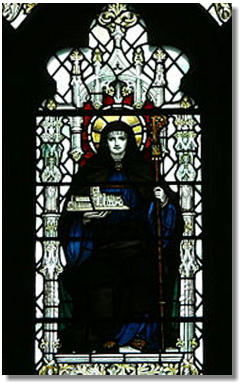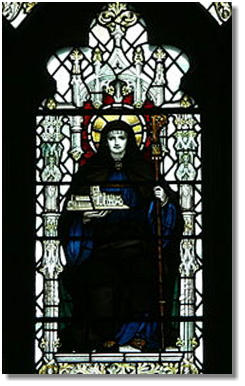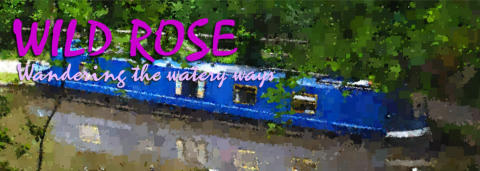

ST. WERBURGH
The shrine to St Werburgh is the magnificent Chester Cathedral. Born in Staffordshire early in the
seventh century she was a Benedictine and patroness of Chester, Abbess of Weedon, Trentham,
Hanbury, Minster in Sheppey, and Ely. Not only this but she had an impeccable royal pedigree. Her
father was Wulfhere, a Mercian king and her mother was also a saint, St. Ermenilda, who was herself
a daughter of a King of Kent and a sainted mother! They just keep on coming.
The legend that is associated with her, being a miracle leading to sainthood, concerns a goose, a very
fat and happy goose. This goose was part of a flock that lived in the convent meadow at Weedon,
swimming in the pond there. This fat and happy goose became her
favourite and she named him Grayking.
Now we come to the obligatory wicked convent steward, Hugh.
The geese pillaged Hugh's corn field as geese do and Hugh was
aggrieved when Werburgh took a lenient view of the incident,
probably because there's not much point in getting angry with a
goose, it just doesn't get you anywhere. Hugh decided on rough
justice and killed and ate Grayking. When Werburgh found out, she
was furious and, recovering the bones of the wretched bird, she
willed him to reconstitute himself.
Lo and behold the goose Greyking reappeared in all his original fat
and happy contentment. Now, as I said, this was a miracle, but only
if you are a high ranking Mercian aristocrat. If, for instance, you are
Werburgh the tinker's wife, then pulling this kind of stunt is more
likely to end in being barbecued at the stake for being a witch.
Thinking about it...not a lot has changed!



ST. WERBURGH
The shrine to St Werburgh is the magnificent Chester
Cathedral. Born in Staffordshire early in the seventh century
she was a Benedictine and patroness of Chester, Abbess of
Weedon, Trentham, Hanbury, Minster in Sheppey, and Ely.
Not only this but she had an impeccable royal pedigree. Her
father was Wulfhere, a Mercian king and her mother was also
a saint, St. Ermenilda, who was herself a daughter of a King of
Kent and a sainted mother! They just keep on coming.
The legend that is associated with her, being a miracle leading
to sainthood, concerns a goose, a very fat and happy goose.
This goose was part of a flock that lived in the convent
meadow at Weedon, swimming in the pond there. This fat and
happy goose became her favourite and she named him
Grayking.
Now we come to the obligatory wicked convent steward,
Hugh. The geese pillaged Hugh's corn field as geese do and
Hugh was aggrieved when Werburgh took a lenient view of
the incident, probably because there's not much point in
getting angry with a goose, it just doesn't get you anywhere.
Hugh decided on rough justice and killed and ate Grayking.
When Werburgh found out, she was furious and, recovering
the bones of the wretched bird, she willed him to reconstitute
himself.
Lo and behold the goose
Greyking reappeared in all
his original fat and happy
contentment. Now, as I said,
this was a miracle, but only
if you are a high ranking
Mercian aristocrat. If, for
instance, you are Werburgh
the tinker's wife, then
pulling this kind of stunt is
more likely to end in being
barbecued at the stake for
being a witch. Thinking
about it...not a lot has
changed!


nb Wild Rose

Wandering the Watery Ways…




























